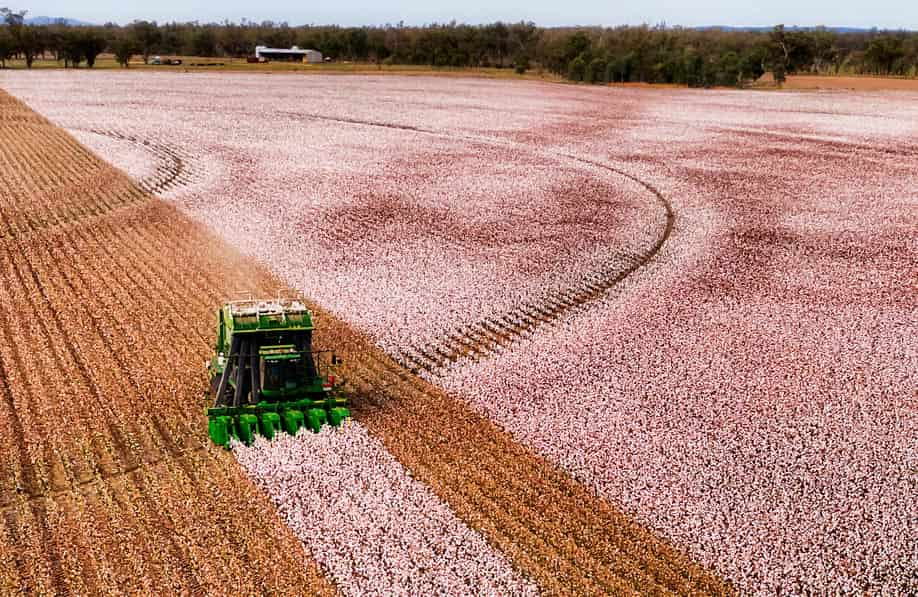Global Water Usage
As the population continues to soar, worldwide water conservation and management in agriculture has become increasingly important. Agriculture accounts for 70% of global water usage, cotton in only responsible for 3% of that1.

In fact, cotton’s natural drought tolerance, minimal irrigation needs and ability to thrive in arid climates make it one of the most versatile crops on the planet. And over the next 10 years, improvements in irrigation technology and new cotton varieties will likely result in further decreases in cotton’s water demand.
Make Every Drop Count
Cotton is drought tolerant, requiring little to no extra water other than natural rainfall in most regions of the world. When it comes to irrigation water needs in cotton production, in the U.S. it breaks down like this:

Irrigation, where required, is critical. In some cases, irrigation can provide a 400% increase in overall yield, which makes precise usage crucial. Advanced technologies such as moisture sensors, weather modeling, and low-energy precision application (LEPA) irrigation are helping to acheive water reduction targets.
Water Usage Improvement
Compared to 20 years ago, we produce much more cotton per acre of land, with virtually no increase in water usage3. In fact, some areas are using even less water than before. This is thanks to improvements in irrigation technologies and the emergence of insect-resistant strains.

Cotton Water Facts
- 177 gallons of water consumption are required to make one t-shirt. This includes both growing the cotton and manufacturing the shirt4.
- 157 gallons of water consumption are required to grow the cotton used in one t-shirt4.
- The water consumption of cotton is less than 3% of the global average of a person’s water footprint4,5,6,7.
- Nearly all of the water applied to the plant is evaporated and returns to other fields as rainfall. This is part of the earth’s natural water cycle4.
- Cotton grown by conventional and organic methods in the same location require the same amount of water to produce. All plants require water to grow, therefore it is important to implement best management practices to increase water use efficiency in any agricultural system.
- Cotton is drought tolerant and will grow when irrigated with brakish (salty) water6, this means cotton can grow where other crops cannot making it an important source of global food and fiber7.
For more information about water usage in cotton visit cottontoday.cottoninc.com
1: Hoekstra, A. Y. & Chapagain, A. K. (2007). Water footprints of nations: water use by people as a function of their consumption pattern. Water Resource Management, (21)1, 35–48.
2: USDA – National Agricultural Statistics Service – Surveys – Census of Irrigation. (2018). USDA.gov. https://www.nass.usda.gov/Surveys/Guide_to_NASS_Surveys/Farm_and_Ranch_Irrigation/
3: USDA – National Agricultural Statistics Service – Surveys – Census of Irrigation. (2018). United States Department of Agriculture. https://www.nass.usda.gov/Surveys/Guide_to_NASS_Surveys/Farm_and_Ranch_Irrigation/
4: Cotton Incorporated (2016). LCA Update Of Cotton Fiber And Fabric Life Cycle Inventory. https://cottontoday.cottoninc.com/wp-content/uploads/2019/11/2016-LCA-Full-Report-Update.pdf
5: Mekonnen, M. M., & Hoekstra, A. Y. (2011). The green, blue and grey water footprint of crops and derived crop products. Hydrology and Earth System Sciences, 15(5), 1577–1600. https://doi.org/10.5194/hess-15-1577-2011
6: OECD/FAO (2018), OECD-FAO Agricultural Outlook 2018-2027, OECD Publishing, Paris/Food and Agriculture Organization of the United Nations, Rome.
7: Water Footprint Network (2020). Personal water footprint calculator. https://waterfootprint.org/en/resources/interactive-tools/personal-water-footprint-calculator/
6: Meiri, A., Frenkel, H., & Mantell, A. (1992). Cotton Response to Water and Salinity under Sprinkler and Drip Irrigation. United States Department of Agriculture. https://pubag.nal.usda.gov/catalog/1381776
7: Cotton Incorporated. (2017). Power Plant: Fiber and Food from Cotton – Cotton Today. https://cottontoday.cottoninc.com/power-plant-fi ber-and-food-from-cotton/
